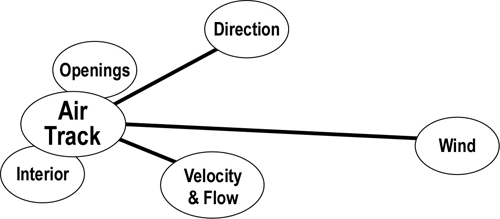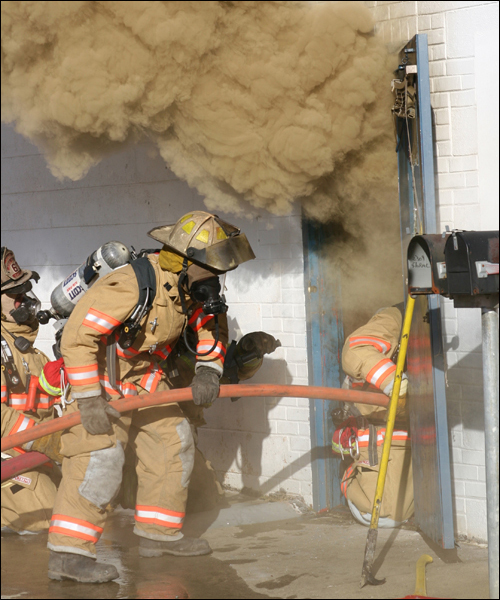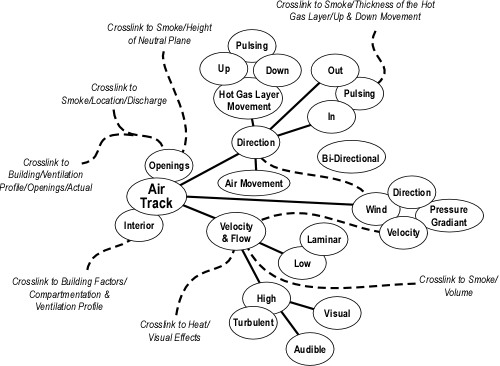Reading the Fire
Air Track Indicators Part 2
Air track includes factors related to the movement of smoke out of the compartment or building and the movement of air into the fire. Air track is caused by pressure differentials inside and outside the compartment and by gravity current (differences in density between the hot smoke and cooler air). Air track indicators include velocity, turbulence, direction, and movement of the hot gas layer.
My prior post, Reading the Fire: Air Track Indicators began the process of developing or refining an existing concept map of air track indicators. It is important to evaluate air track at openings and on the interior of the structure. As a starting point, I have identified direction, velocity & flow, and wind as basic air track indicator categories (see Figure 1). However, you may choose to approach this somewhat differently.
Figure 1. Basic Air Track Indicators

Air track indicators provide critical cues related to stages of fire development, burning regime, and potential for fire spread. However, it is essential that assessment of air track be integrated with other categories of indicators in the B-SAHF scheme to gain a clearer sense of fire conditions and likely fire behavior. Remember that looking at air track alone may be misleading.
Air Track at Openings and on the Interior
Discharge of smoke at openings and potential openings (Building Factors) is likely the most obvious indicator of air track while lack of smoke discharge may be a less obvious, but potentially important sign of inward movement of air.
Observation and interpretation of smoke and air movement at openings is an essential part of air track assessment, but it must not stop there. Movement of smoke and air on the interior can also provide important information regarding fire behavior.
The path taken by the air track will define the direction of fire spread and may present a significant hazard to firefighters operating between inlet and exhaust openings. This necessitates ongoing assessment of air track from both the exterior and interior of the building.
Figure 2. Air Track

Direction
Consider the following observations. You arrive at a fire in a commercial building and observe smoke showing from a door on floor 1 (Figure 2).
The smoke discharge fills the upper half of the door while it appears that air is moving in the bottom half of the door. What can you infer from this? What would you infer if the smoke discharge completely filled the door?
The direction of the air track can also provide valuable cues to fire behavior. When air moves in an opening (inlet) without any smoke discharge, it is likely that smoke is exiting from another opening (exhaust). When this condition is reversed, and smoke comes out with not inward movement of air, it is likely that another opening is serving as an inlet. When the air track is bi-directional and air moves in at the bottom and smoke moves out at the top, this may be the only opening in the compartment or ventilation from other exhaust openings may be inadequate. In any case where smoke is discharging through an opening, the fire is likely moving in that direction.
Mixing of smoke and air occurs at the interface between the hot gas layer and cooler air below. This is a critical factor in creating the conditions required for backdraft and many types of fire gas ignitions. Pulsing air track, outward movement of smoke followed by an inward movement of air is indicative of an underventlated fire and potential backdraft conditions (consider other indicators in determining if backdraft conditions are likely to exist). It is critical to remember that these pulsations can vary in duration and that backdraft does not generally occur immediately upon making an opening. The time between making an opening and occurrence of a backdraft is dependent on many factors including distance of the compartment with backdraft conditions from the opening. Air track is an extremely useful indicator, but it must be integrated with a big picture evaluation of fire behavior indicators.
Location of inlet and exhaust openings (particularly if they are on different levels or if impacted by wind) is an important Building Factor that directly impacts air track. This is an excellent example of why each of the categories of fire behavior indicators (FBI) must be considered together when reading the fire.
Velocity & Flow
Velocity and flow are two interrelated air track factors. Velocity refers to the speed of smoke and air movement. However, the speed with which smoke is traveling (either out of an opening in the compartment or building or within a compartment) must be considered in relation to the size of an opening or conduit. Flow may be either smooth (laminar) or turbulent. This is dependent to a large extent on velocity. High velocity generally results in turbulent flow through a compartment (such as a hallway) or out an opening (e.g., doorway or window). For a given volume, velocity and turbulence will be higher through smaller openings). High velocity smoke discharge and turbulent flow is generally indicative of high temperature within the compartment (another connection, in this case between air track and heat).
Wind
Wind can influence smoke movement on the exterior of a building (in some cases masking exterior air track indicators) or it can have a more direct influence on air track. As discussed in a number of earlier posts, wind can have a significant influence on compartment fire behavior.
- Wind Driven Fires
- NIST Wind Driven Fire Experiments: Establishing a Baseline
- NIST Wind Driven Fire Experiments: Anti-Ventilation Wind-Control Devices
- NIST Wind Driven Fire Experiments: Wind-Control Devices and Fire Suppression
- Wind Driven Fires: Tactical Problem
Understanding the potential influence of wind on fire behavior, provides a basis to read and interpret air track indicators. Wind exerts pressure on structural surfaces (see Figure 3), which under fire conditions can have a significant influence on movement of both smoke and air.
Figure 3. Distribution of Pressure due to Wind

Note. Adapted from Fire Ventilation (p. 34-35) by Stefan Svensson, 2000, Karlstad,Sweden: Räddnings Verket. Copyright 2000 by Stefan Svensson & Räddnings Verket.
Wind on an inlet opening can act much the same as a supercharger, dramatically increasing heat release rate, fire intensity, and rate of spread (see Figure 4).
Figure 4. Wind Effects

Movement of the Hot Gas Layer
Horizontal movement of the hot gas layer and turbulence at the interface between smoke and clear air below indicate air track direction. As discussed in Reading the Fire: Smoke Indicators height of the hot gas layer is a significant indicator of fire conditions. Even more important than the height of the hot gas layer, are changes in height. A sudden rise could indicate that ventilation has occurred (either performed by firefighters or caused by the fire). Gradual lowering of the hot gas layer could indicate worsening conditions and increased potential for flashover. However, inappropriate or excessive application of water can also cause lowering of the hot gas layer. Sudden lowering could indicate worsening conditions caused by flashover in an adjacent compartment. While not commonly known as a backdraft indicator, raising and lowing of the hot gas layer is similar to a pulsing air track observed at an opening (however in this case the compartment is not fully smoke logged, so the expanding and contracting gases cause the bottom of the hot gas layer to move up and down).
Height and more importantly vertical movement of the hot gas layer may be considered as Smoke or Air Track Indicators (a good argument can be made in either case). For now, I have chosen to position these two types of indicator under Smoke, but with linkage to Air Track, but I am considering moving them to Air Track (while maintaining linkage to Smoke Indicators).
Work in Progress
Hopefully we have been working on this project together and you have been developing or refining the air track segment of your fire behavior indicators concept map. My current map is illustrated in Figure 5.
Figure 5. Air Track Indicators Concept Map v5.2.2.1

You can also download a printer friendly version of the Air Track Indicators Concept Map v5.2.2.1 (including notes made during development). As indicated by the significant number of notes in the Staging Area of the printer friendly version, a bit more work remains to be done before integrating the Smoke and Air Track indicators in the complete version of the Fire Behavior Indicators Concept Map. Should you have any suggestions or feedback, please post a comment!
Ed Hartin, MS, EFO, MIFireE, CFO
References
Svensson, S. (2000). Fire ventilation. Karlstad, Sweden: Räddnings Verket.
Tags: air track, B-SAHF, deliberate practice, FBI, fire behavior indicators, reading the fire, situational awareness



August 13th, 2009 at 07:03
[…] Air Track Indicators Part 2 […]
September 17th, 2009 at 10:16
[…] Air Track Indicators Part 2 […]
September 12th, 2010 at 10:19
[…] Air Track Indicators Part 2 […]
November 29th, 2010 at 09:01
[…] Reading the Fire: Air Track Part 2 […]
November 9th, 2011 at 06:00
[…] discussed in Reading the Fire: Air Track Indicators Part 2, these indicators can be displayed in a concept map to show greater detail and their […]
February 14th, 2012 at 07:20
[…] Reading the Fire: Air Track Part 2 […]